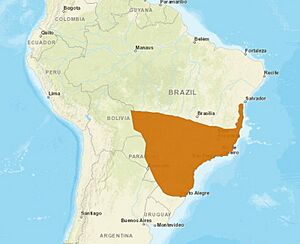Southern tigrina facts for kids
Quick facts for kids Southern tigrina |
|
|---|---|
| Conservation status | |
| Scientific classification | |
| Genus: |
Leopardus
|
| Species: |
guttulus
|
 |
|
| Distribution of the southern tigrina, 2016 | |
The southern tigrina (also called the southern tiger cat) is a small wild cat. Its scientific name is Leopardus guttulus. You can find it in countries like Brazil, Argentina, and Paraguay.
Contents
What is a Southern Tigrina?
In 1872, a scientist named Reinhold Hensel first described this cat. He found it in the jungles of southern Brazil. He gave it the scientific name Felis guttula.
For a long time, people thought the southern tigrina was just a type of oncilla. An oncilla is another small wild cat. But in 2013, scientists realized it was its own unique species.
The southern tigrina is also related to Geoffroy's cat. Sometimes, these two cat species have babies together in southern Brazil.
How to Spot a Southern Tigrina
The southern tigrina has a yellowish-brown coat. It has cool black spots that look like open flowers, called rosettes. It is a bit darker than the oncilla. Its spots are also bigger, and its tail is a little shorter.
It can be very hard to tell the southern tigrina and the oncilla apart just by looking. This is because cats within each species can look very different from each other. An adult southern tigrina usually weighs between 1.9 and 2.4 kilograms (about 4 to 5 pounds).
Where Southern Tigrinas Live
You can find the southern tigrina in central and southern Brazil. They also live in eastern Paraguay and northeastern Argentina. They live in places below 2,000 meters (about 6,500 feet) high.
Scientists think there are about 6,000 adult southern tigrinas in the wild. They live in many different places. These include thick tropical forests, pine forests, open grasslands, and even beach areas.
Sometimes, southern tigrinas live near Geoffroy's cats. When they do, they can have mixed babies. But southern tigrinas do not seem to mix with oncillas. This is because they live in different types of habitats.
What Southern Tigrinas Eat
Southern tigrinas mostly hunt small animals. They eat small mammals, birds, and lizards. Their usual prey weighs less than 100 grams (about 3.5 ounces). But they can also catch bigger animals, up to 1 kilogram (about 2.2 pounds).
Southern tigrinas often live in the same areas as ocelots. Ocelots are larger wild cats. If there are many ocelots, there are usually fewer southern tigrinas. This is because ocelots compete for the same food and shelter.
When there are not many ocelots, smaller cats like the southern tigrina have more chances to find food and safe places. This helps their population grow. This idea is called the "ocelot effect."
In 2015, scientists saw two young southern tigrinas learning to hunt. They were in the Atlantic forest. They caught a cavy, which is a type of rodent. Mother cats are very important. They teach their babies how to hunt and survive.
Threats to Southern Tigrinas
In the past, many southern tigrinas were hunted for their fur. Today, they face other dangers. These include losing their homes because of deforestation. People also sometimes hunt them. They can get hit by cars on roads. Diseases from pet dogs can also harm them. Using poison for rodents can also hurt them.
Protecting Southern Tigrinas
Southern tigrinas live in protected areas. But their numbers there are often low. Scientists are working hard to learn more about these cats. They want to understand their lives, how they have changed over time, and their genes. This will help create better plans to protect them.
More research is also being done to understand the differences between oncillas and southern tigrinas. Hunting southern tigrinas is now against the law in Argentina, Brazil, and Paraguay.
How Southern Tigrinas Evolved
Scientists believe that the southern tigrina became its own species after the last ice age. This happened about 20,000 years ago. As the climate changed, their population grew and spread out. This led to them becoming a separate species.


